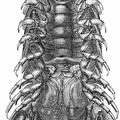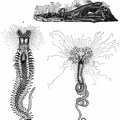933/1613
A Minute Portion of the Pulp of the Spleen,very highly magnified.
Stellate connective-tissue cells form spaces containing red blood-corpuscles and leucocytes. In the centre of the diagram is shown the mode of origin of a venule. It contains two phagocytes—the upper with a nucleus, two blood-corpuscles just ingested, and one partially digested in its body-substance; the lower with two blood-corpuscles.
- Author
- The Body at Work
by Alexander Hill
Published 1908
Available from gutenberg.org - Posted on
- Tuesday 1 September 2020
- Dimensions
- 750*867
- Keywords
- human
- Albums
- Visits
- 821
- Downloads
- 39
 Download Photo
Download Photo





